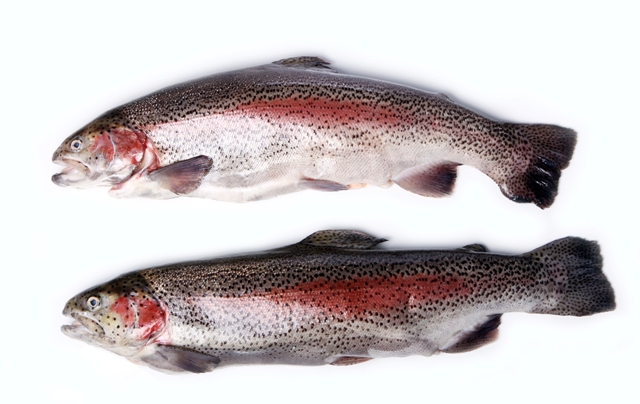Trout is a nutritious fish belongs to Salmonidae family. It has been traditionally used for numerous therapeutic and culinary purposes.
General information regarding trout
- They are strongly related with char and salmon
- Basically trout is considered as the common name for several species like rainbow trout, brook trout, brown trout etc among all of these species rainbow trout is very common and widely available in grocery stores
Nutritional profile
Carbohydrates
- It contains negligible amount of carbohydrates thus it is considered as low glycemic food
- Being a low glycemic food it can be easily incorporated in the diet of diabetic patients
Proteins
- It is considered as a rich source of protein and the proteins present in trout are of high biological value
- It is composed of various important amino acids
- It contains both essential as well as non-essential amino acids
- It is especially rich in glutamic acid, arginine, aspartic acid, lysine and leucine
Fats
- It contains desirable amount of fat
- It is composed of both saturated and unsaturated fatty acids and mainly rich in unsaturated fat thus it is considered as healthy fat food
- Omega 3 fatty acid is the primary fatty acid found in trout, which is responsible for providing numerous health benefits


Vitamins
- It contains both fat soluble and water soluble vitamins, which have numerous biological roles in body
- It contains desirable amount of Vitamin D that helps in strengthening skeletal health
- It contains Vitamin A as well, which is responsible for promoting eye health and vision
- It is also consisting of B vitamins that play vital role in metabolism, circulation and help in improving nervous system as well
- It contains Vitamin C too
Minerals
- It contains various important minerals, which include calcium, phosphorus, magnesium, potassium, iodine, selenium and iron
- All of these trace elements are accountable for offering several health benefits
Health benefits
Role on cardiac health
- It is widely used as an important therapeutic substance for cardiac health as it contains numerous cardio friendly nutrients that help in promoting cardiac health and play vital role in reducing the risk of developing cardio vascular diseases
- Its omega-3 fatty acid content plays significant role in reducing the level of LDL in body, which ultimately helps to prevent plaque formation by inhibiting fat deposition within blood vessels as a result helps in decreasing the susceptibility of blockage as well as atherosclerosis and helps in smooth blood circulation
- Consumption of trout is also responsible for decreasing the prevalence of coronary artery disease, angina pectoris, myocardial infarction
- It has seen that individual who consume trout are less susceptible to develop heart attacks and strokes
- It helps to prevent hypertension too and all the credit goes to its potassium content. Potassium present in trout acts as vasodilator

Role on immunity
- Consumption of trout is really very effective for improving overall immunity of the body as it contains numerous immune boosting nutrients
- Proteins found in trout play significant role in stimulating the synthesis of antibodies or immunoglobulins, which help in improving the immunological responses of the body
- Its antioxidant activity is also accountable for protecting every immune cell from oxidative damages as a result helps in promoting their activity, which ultimately helps to strengthen the defense mechanism of the body
- Vitamin C present in trout helps in increasing the production of WBC, which is responsible for making the body able to fight against infections
Role on nervous system
- It is very effective for improving the overall functionality of nervous system
- Its protein contents help in the growth and development of brain
- Its B vitamin components help in improving brain’s activity
- It is also associated with preventing oxidative and inflammatory damages of nerve cells as a result helps in sustaining their activity, which significantly reduces the prevalence of neurological disorders
- It is very effective for improving the symptoms of Alzheimer’s diseases
- It helps to prevent mental declaiming as well
- It has seen that individual who consume fish especially trout have more gray matter, the major part of central nervous system
- It helps to improve memory too
- It is also related with improving cognitive ability as well as learning skills


Role on mental health
- Its consumption is really very effective for improving mental health as well
- Omega-3 fatty acid found in trout helps to fight against depression, which is a very common and serious health issue that affects several people worldwide
- It plays significant role in improving mood as well
- It also helps to reduce the prevalence of bipolar disorder
- It is associated with preventing insomnia as well, which helps to improve sleeping quality thus helps in refreshing the body as well as the mind
Role on skeletal health
- Consumption of trout is very beneficial for maintaining a healthy skeletal system as it contains significant amount of calcium, phosphorus and Vitamin D
- Calcium and phosphorus help in healthy bone formation whereas Vitamin D helps in calcium absorption
- It helps to increase bone mass and density by promoting bone mineralization, which ultimately helps to prevent bone thinning as a result helps in reducing the prevalence of bone fractures
- Individual who consume trout are less susceptible to develop bone disorders in later life because it provides all nutrients, which are essentially required for healthy bones
- It significantly improves the symptoms of osteoporosis as well

Therapeutic uses
It has been extensively used for various therapeutic purposes, like –
- It is used as an imperative anti-inflammatory substance. It helps in preventing inflammation by decreasing the concentration of inflammatory mediator in body. It is widely used as an important remedial action for asthma especially among children. Asthma is a condition in which an inflammation occurred within the airways and being an anti-inflammatory substance its consumption plays vital role in improving the symptoms of asthma
- Vitamin D and omega-3 fatty acid components of trout help in preventing auto-immune diseases thus its consumption is thought to be very helpful for decreasing the prevalence of type 1 diabetes mellitus, multiple sclerosis, rheumatoid arthritis etc
- It is also associated with preventing the prevalence of age related macular degeneration
- It helps to protect the body from free radical induced oxidative damages as well, which ultimately reduces the risk of developing chronic diseases as a result promotes overall wellbeing
- It helps in promoting endothelial health and functionality as well
- It is really very effective for decreasing the concentration of cholesterol especially VLDL and LDL in body, which helps in decreasing the risk of developing hypercholesterolemia. Whereas it is related with increasing the concentration of HDL too, thus its consumption is thought to be very effective for obtaining a healthy lipid profile
- Proteins present in trout help in the overall growth and development of body as well

General consideration of using trout
- While purchasing trout it should be kept in mind that trout should smell fresh. It is better to avoid the purchasing of those trout that have fishy smell or ammonia like smell or sour smell
- The flesh of the trout should be firm, shiny and it should be free from slime as well
- It is better to store trout immediate after purchasing and it should be used within two days
- It is better to cook trout at a temperature of 145 degree Fahrenheit

Source:
Arismendi, I., Penaluna, B., Gomez-Uchida, D., Di Prinzio, C., Rodríguez-Olarte, D., Carvajal-Vallejos, F.M. and Savaria, P., 2019. Trout and char of South America. Trout and char of the world, pp.279-311.
Bruni, L., Husein, Y., Secci, G., Tulli, F. and Parisi, G., 2021. Rainbow Trout (Oncorhynchus mykiss) Skin as Potential n-3 Fatty Acid Source. Waste and Biomass Valorization, pp.1-9.
Dewailly, E., Ayotte, P., Lucas, M. and Blanchet, C., 2007. Risk and benefits from consuming salmon and trout: a Canadian perspective. Food and Chemical Toxicology, 45(8), pp.1343-1348.
Hatte, V.M., 2017. A Study on Consumption Pattern of Trout in Kashmir Valley, India. International Journal of Pure & Applied Bioscience, 5, pp.290-299.
Turchini, G.M., Hermon, K.M. and Francis, D.S., 2018. Fatty acids and beyond: Fillet nutritional characterisation of rainbow trout (Oncorhynchus mykiss) fed different dietary oil sources. Aquaculture, 491, pp.391-397.









